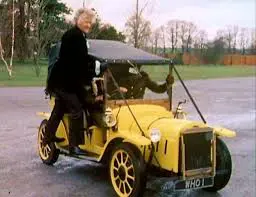STARS AND THEIR CARS - DOCTOR WHO AT SIXTY
15 November 2023
At 5:15 p.m. on Saturday 23rd November 1963, after Grandstand and before The Telegoons and Dixon of Dock Green, BBC Television premiered the first episode of a series they billed as “A new adventure in time and space”. And the first car to be seen in Doctor Who was a Wolseley 6/80 – albeit only the front half, which the production crew mounted on castors.
That Wolseley in An Unearthly Child was the harbinger of countless vehicles to appear in the original run of Doctor Who from 1963 to 1989. The Triumph Spitfire Mk. II in Logopolis comes to mind, as do the police Jaguar S-Types in Terror of the Autons and the Citroën Dyane 6 sans doors in The Sea Devils. Meanwhile, Range Rover devotees will note the example in The Green Death is a 1970 pre-production model fitted with a Powr-Lok differential.

Jon Pertwee’s tenure from 1970 to 1974 provides some of the best opportunities for keen automotive enthusiasts. The storylines established that the Third Doctor was earthbound and attached to UNIT. He was also the first Doctor in colour (please – no debates about the two 1960s Peter Cushing films), so the likes of the Austin Maxi 1500 in Terror of the Autons could be seen in their full glory.
The two cars most associated with Pertwee are ‘Bessie’ and the Whomobile. The former was a GRP kit sold by Siva/Neville Trickett (Design) Ltd. of Blandford in Dorset to motorists who wished to convert their side valve Ford into an ‘Edwardian Tourer’. Buyers could specify a two or four-seater version, and the producer Barry Letts chose the latter: “We think viewers will grow quite affectionate towards Bessie”.
The basic kit cost £160 and employed the chassis of a side-valve Ford. Keen buyers could also choose from an array of options, and naturally, Bessie featured bulb horns, a luggage trunk, Cibie headlamps and coach lamps, a hood and side curtains, a battery box, seat covers, screen and bonnet straps and a carpet. Such extras meant the bill to UNIT would have been £342.
The extra weight of the new body combined with the 1,172cc engine from a 1954 Ford Popular engine meant Bessie’s actual top speed was 15 mph. To be fair, the likes of the Daleks and the Cybermen were not renowned for their turn of speed, and besides, the Third Doctor’s Siva boasted an anti-theft force field, a gravity stabilizer, and a minimum inertia hyperdrive.
However, by 1973, Pertwee had wisely had Bessie fitted with a larger engine – note the longer bonnet. She wore a ‘WHO 1’ plate when driven off the highway. When on the road, Bessie carried her official MTR 5 registration - the directors employed long shots so viewers could not detect the change of plates.
Bessie’s finest hour has to be The Daemons, aka Quatermass and the Pit for Children. Here is a Third Doctor episode that more or less has it all – Pertwee at his most imperious, Roger Delgado and his Beard of Evil as The Master, and the wonderful Damaris Hayman. All this, plus Nicholas Courtney as Brigadier Lethbridge-Stewart uttering the immortal line – “Chap with the wings - five rounds, rapid”.
As for the Whomobile, Pertwee – a noted automotive fanatic offscreen - commissioned it at his own cost. Power was from a tuned Hillman Imp engine - “a real popped-up engine”, in Pertwee’s words - and Peter Farries created the GRP bodywork. The actor was highly taken with the designer’s Model T-based dragster he encountered when opening a Nottingham Ford dealership in January 1973. He gave Farries two criteria for the Whomobile – it had to be road-legal and look as though it hailed from outer space.
The result sported a hovercraft-style rubber skirt to disguise a three-wheeled layout from a Bond Bug and a windshield from a 1960s speedboat to make it road-legal. The top speed was 105 mph, and the Whomobile could cruise at 55 mph. Surprisingly, it appeared only in two adventures: Invasion of the Dinosaurs and Planet of the Spiders.
The latter marked Pertwee’s swansong as The Doctor, which brings this writer to his favourite Doctor Who car moment. The elaborate and totally pointless car chase in Spiders may look suspiciously like pandering to an actor about to depart from the series, but it is quintessential 1970s Doctor Who. Including that ubiquitous prop Austin 1300 police Panda Car from many a BBC production and the finest Chromakey available to humanity. What is there not to like?
